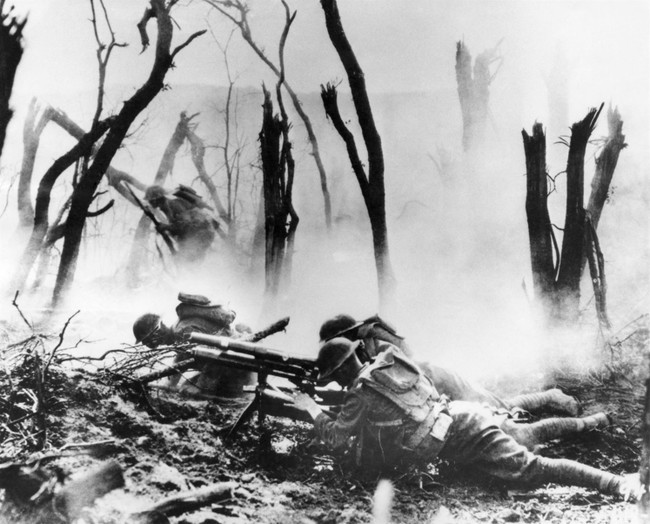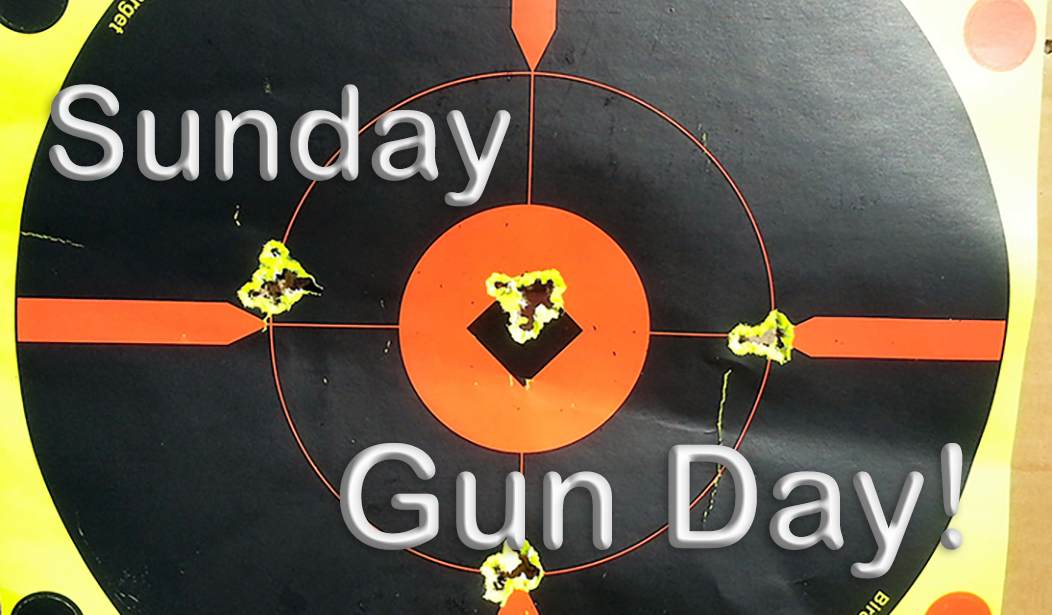The Great War: A War of Bolt Guns
Previously on RedState: Sunday Gun Day XXIX - The History of Bolt Guns, Part I
Sunday Gun Day XXX - the History of Bolt Guns, Part II
Sunday Gun Day XXXI - The History of Bolt Guns, Part III
The 1914-1918 War, otherwise known as the Great War or World War I, was a horrific, world-changing event. I won’t go into the causes of the conflict or the issues that arose from it, as that’s a story to be told some other time. But whatever else it was, the Great War was the war of the bolt gun. The War to End All Wars was the crucible in which the modern bolt-action rifle was formed, hardened, and tempered.
In this conflict, all the major players were using bolt-action rifles. Autoloaders were, at this time, a novelty, considered too unreliable for martial use. (There was at least one exception, which we’ll note later.) Single-shot breechloaders were obsolete. With a few exceptions lever guns never caught on as primary battle rifles. World War I introduced the horrors of the machine gun, the airplane, and the tank, but the primary soldier’s weapon was a turn-bolt rifle.

The Allies
Britain and her Empire entered the war with the No. 1 Mk III Short Magazine Lee-Enfield (SMLE) as their primary service rifle. The “Smelly” was a good infantry rifle, reliable, powerful, and with twice the magazine capacity of most of its competition. Its smooth action, rear-mounted bolt handle that placed the firing hand near the bolt handle when in operation, and the high magazine capacity for the time all combined to make for a high rate of fire. Lee-Enfield rifles were at this time made around the Empire, mostly in the UK at not only the Enfield arsenal but also at the Royal Small Arms Factory at Smallbrook, the BSA and LSA small arms companies, the Lithgow Small Arms factory in Australia and the Ishapore Arsenal in British India. Post Great-War variants were also made at the Long Branch Armory in Canada and by Savage Arms in the United States.
France entered the war with a few older Gras, Kropatschek, and Lebel rifles in inventory, but their primary Great War arm was the various marks of the Berthier rifle, a three or five-round bolt gun firing the good old 8mm Lebel cartridge and later adapted to the new 7.5x54mm French service round. The Berthier-pattern rifles were invented by a French civil engineer, Emile Berthier, whose primary occupation was the building of railroads; nevertheless, he came up with a pretty fair infantry weapon. About two million of these guns were made in various configurations.
In 1917, though, France did something unexpected; preceding America’s famous M1 Garand by quite a while, France adopted an autoloader, the Fusil Automatique Modèle 1917. I know this is a discussion of bolt guns, but this merits a mention; the Model 1917 was a gas-operated semi-auto that held five rounds of 8mm Lebel ammo in a clip-fed internal box magazine. The rifle had some serious issues with reliability; from 1917 to 1921 only about 90,000 were made.
The Kingdom of Belgium used a variety of rifles in the Great War, including the French Gras and Lebel rifles, but their primary arm was the 1889 Belgian Mauser, which was produced for the Belgian Army by the famed Fabrique Nationale until that works was overrun by the Germans, the first of two times that would happen in the 20th century. While FN was in German hands, the Kingdom outsourced the manufacture of the M89 rifle to Greener in England and Hopkins & Allen in the United States. The M89 Belgian Mauser proved to have some serious staying power, as some were still in use by the Republic of Congo/Leopoldville as late as 1960.
The Russian Empire’s participation in the Great War was cut short by two uprisings that saw the Tsar and his family dead and, in time, a new Bolshevik government in place. The result of this was the formation of the Soviet Union in 1922, but the primary arm of the Red Army didn’t change; the 1891 Mosin-Nagant served Red Army soldiers as it had Imperial Russian soldiers before.
I’m probably overly fond of twitting Mosin-Nagant aficionados with the roughness of that arm. (All in good fun, of course.) But the fact is that the Mosin-Nagant is a rifle admirably suited for what it was designed for: rough use in the field and casual maintenance by poorly educated peasant soldiers. Years after the Mosin-Nagant first saw service, a Soviet designer named Mikhail Kalashnikov designed a select-fire, medium-power short rifle with much the same types of soldiers in mind, and that arm was as successful in peasant armies worldwide as the Mosin-Nagant before it.
It’s the mark of a good martial rifle that it suits the intended user.
The Central Powers
The GEW 98 saw the Imperial German Army through the Great War for the most part. But the need for a shorter, lighter arm for cavalry and artillery units had led to the development of the kar98a in 1902, and that small-ring 98 carbine saw service with those mobile units in the Great War. Some years ago, I managed to obtain a kar98a with an original bayonet. I ran a few boxes of 8mm ammo through it – it kicked like a mule – and eventually, regrettably, ended up trading it off.
I really need to think twice before selling/trading away a gun, given how often I end up wishing I hadn’t; but I also lack a giant Scrooge McDuckian vault to store my collection in, so…
We’ve already discussed the Gewehr 98, so I won’t revisit that ground. It’s worth remembering that the Gewehr 98 was produced and fielded in great numbers, with over nine million being made. It’s not particularly hard to find decent examples of this rifle today. This first of the 98 Mauser service rifles was a great success, and it proved to be only the beginning of the career of this famous bolt gun action.
In 1918, with the British beginning to field the MkI tank in some numbers, Mauser responded with their first attempt at an anti-armor weapon, that being the 13.2mm Mauser 1918 T-Gewehr, or anti-tank rifle. This single-shot behemoth fired a .525 caliber, 795 grain bullets at about 2500 fps, and proved dangerous to the armor of the time. While post-Great War advances in armor would swiftly make the anti-tank rifle obsolete, the T-Gewehr nevertheless remained in use until 1933.
Meanwhile, the Ottoman Turks were building their own version of the Gewehr 98. The M1903 Turkish Mauser was more or less a clone of the German rifle, using a large-ring 98 Mauser action and much of the same specifications. There was one oddity in the Turkish guns: While they had a large-ring action, they used a barrel threaded to the pattern used for small-ring actions.
When examining the Turkish Mausers, it’s important to note the manufacturer. Guns made by Mauser were of good quality, but the guns I have examined that were built at Turkey’s Ankara appear to be of rather slapdash workmanship. Also, late in the Great War and for a few years afterward, some guns were assembled from parts with little regard for such things as tolerances and headspace.
While the Turks were whiffing at the quality pitches, the Austro-Hungarian Empire had examined the rifles produced by one Ferdinand Mannlicher and found them worthy, and that evaluation was spot-on. The Mannlicher designs included the M1890 carbine and the M1893 rifle, both traditional bolt guns, and the M1895 straight-pull bolt rifle.
The United States: Early Player, Late Entry
By the time the Great War’s western front had settled into an entrenched, fixed war of attrition, the British Empire was having trouble producing enough Lee-Enfield rifles to meet the needs of the troops. In what was to prove a prescient move, they looked across the Atlantic to one of the Empire’s estranged offspring, who had grown mighty.
The United States already had a substantial firearms industry by 1914. Designers like John Browning and Sam Colt had made their name in the firearms world, so it wasn’t unreasonable for the British to think that America may be able to help supply their Tommies with shooting irons.
For a bit of relevant history, we must go back to 1899, to the Second Boer War. The British were faced in that conflict by sharp-shooting Boer farmers mostly equipped with 1893 and 1895 Mausers firing the high-velocity 7x57mm cartridge. To match that performance, in 1910, the British War Department developed their own 7mm cartridge, the .276 Enfield, and built a Mauser-pattern bolt gun to fire it, which was designated the Pattern 13 Enfield. However the outbreak of the Great War dissuaded the War Department from attempting to field a new rifle and a new cartridge, so production of the No. 1 Mark III SMLE continued.
But the pattern was not forgotten. In 1914, the British Army contracted with the American manufacturers Remington and Winchester to produce a version of the Pattern 13 Enfield modified for the standard .303 cartridge. This new rifle, the Pattern 14 Enfield, was slow in development, and the British Army received no rifles until 1916. Relatively few of these guns were delivered, and their long barrels and excellent accuracy resulted in most of them being used as sniper rifles. The Pattern 14 was well suited for this, with a long (26”) barrel, good sights with the rear peep solidly protected by big steel mule-ear projections and the front sight likewise surrounded by steel guards. It was a heavy, long piece but not unusually so for the time, and proved to be a good shooter.
But the Enfield pattern didn’t end there. When the United States entered the Great War in 1917, Remington, Winchester, and the Eddystone Arsenal (a Remington property) quickly retooled to produce the Enfield design in the standard American rifle cartridge, the redoubtable caliber .30 Model of 1906.
This new piece became the M1917 Enfield rifle, and with three manufactories putting them out, the Enfield surpassed the standard issue 1903 Springfield in numbers supplied to American doughboys. No less a figure than Alvin York performed his famous acts of marksmanship not with a Springfield, as has been shown in movies, but with an M1917 Enfield.
A bit over two million M1917 rifles were built, and about one and a quarter million of the earlier Pattern 14 guns. Later, the Pattern 14 actions became popular for rebarreling with the big new belted magnums that were making their appearance, as the .303 case head was similar in diameter to the belted magnums introduced by Holland & Holland. Any reasonably-sized gun show in the United States to this day will have a few of these rifles on display.
The Aftermath
On the eleventh hour of the eleventh day of the eleventh month, the Great War ended.
In the United States, 4.7 million doughboys returned home, bringing their new-found familiarity with the Springfield 03 and M1917 Enfield rifles with them. Many of them who were outdoorsmen and shooters, a proportion of the populace likely higher today than now, had cut their teeth on lever guns, but the accuracy and power of the military bolt guns and the .30-06 cartridge had made an impression.
The Springfield Armory got in on the action, producing a civilian-sale version of the 1903 rifle known as the NRA Sporter, and plenty of surplus rifles were converted to sporters, as were many captured and surrendered Mausers and Mannlichers as well as Smellies and others.
But that wasn’t going to keep up with demand. American gun companies responded, and Remington was an early bird, adapting the Pattern 17 action into a civilian sporter and releasing it in 1921 as the Remington Model 30, initially available only in .30-06 but later in a variety of chamberings. This was, of course, just the beginning. Winchester and many other manufacturers were quick to follow; things were, as the kids say nowadays, about to get real — and bear in mind this was a civilized time when politicians were less apt to blame a sword for the hand that wields it, the firearms industry was free to engage in development, and "weapons of war" were readily accepted for civilian use.
See Related: Federal Judge: Biden Admin 'Ghost Gun' Ban Doesn't Go Far Enough
Trump's Bump Stock Ban Not Likely to Survive the Supreme Court
And Then This Happened
The War to End All Wars… didn’t. The sequel, World War II, again saw most of the major players operating bolt guns at the outset; the Brits used their updated Lee-Enfield throughout that conflict, the Soviet Union and Germany started with bolt guns and experimented with autoloaders The United States mostly used the ground-breaking semi-auto M1 Garand throughout, although a fair number of 1903 and the later, cheaper 1903A3 bolt guns saw service early in the war. And, of course, today, the bolt gun is absent from military use except in certain highly specialized applications, like snipers.
But the Great War Part Two didn’t see much change in martial bolt guns. There were some minor updates to Enfield, Mauser, Carcano, Mosin-Nagant, and other rifles, but the form was pretty much set, and the rise of the military autoloader would see the bolt gun slowly phased out of the world’s armed services.
On the civilian side, though, things were just getting started in 1918. The bolt gun, with its strong, solid action capable of handling high-pressure cartridges, with its solid attachment of barrel to receiver with sights permanently fixed in place, had proven to be reliable, accurate, and powerful. What’s more, that solid receiver was ideal for mounting the newfangled telescopic sights that were becoming popular.
The new trend in the game fields post-WWI was towards bolt-action sporters, and a great expansion of rifles and cartridges was about to take place. More on that in another segment, in which we shift focus from military rifles to civilian sporters, which, in my opinion, are more fun. And finally, we’ll examine the state of the bolt gun today. Stay tuned.














